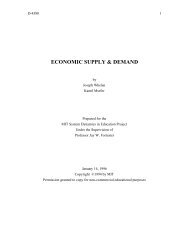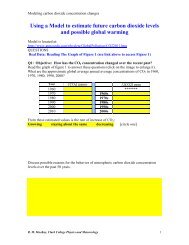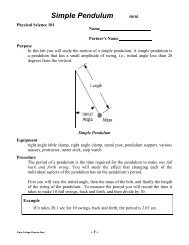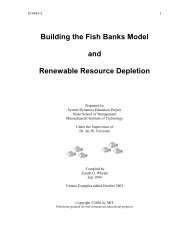Unexpected Behaviors in Higher- Order Positive Feedback Loops
Order Positive Feedback Loops - Creative Learning Exchange
Order Positive Feedback Loops - Creative Learning Exchange
- No tags were found...
You also want an ePaper? Increase the reach of your titles
YUMPU automatically turns print PDFs into web optimized ePapers that Google loves.
20 D-4455-2exponential growth. But still keep <strong>in</strong> m<strong>in</strong>d that unexpected behaviors are possible, evenlikely, and they are bound to be quite complex.4. APPENDIX A: SOME SOLUTIONS TO EXPLORATIONS4.1 Second-order SystemMake a comparative scatter graph of a vs. b, and try many <strong>in</strong>itial values of aand b; what pattern emerges?This geometric pattern (shown <strong>in</strong> Figure 13.) is called a saddle. To see why it isgiven this name, imag<strong>in</strong>e lett<strong>in</strong>g a marble roll off an actual horse saddle. It moves alongthe surface, fall<strong>in</strong>g down the sides where one’s legs would normally go. If you were ableto place the marble just right, you could balance it <strong>in</strong> the center of the saddle, and it wouldnot fall <strong>in</strong> either direction. If you were even more careful, you could place the marble nearthe top of the saddle, still centered left and right, and it would roll down to the center, butnot fall to either side. If the saddle were sticky, then the marble would also slow to a stopat the center, just as we have <strong>in</strong> our saddle here. The two orbits with <strong>in</strong>itial conditions (-3,3) and (2, -2) are <strong>in</strong> a balanced path along the saddle. They exponentially approach theorig<strong>in</strong>, while orbits to either side quickly zoom off to <strong>in</strong>f<strong>in</strong>ity.










